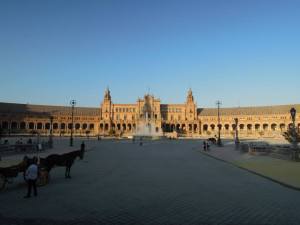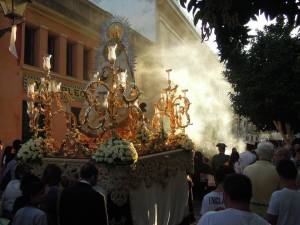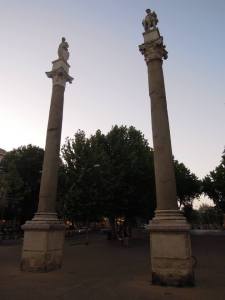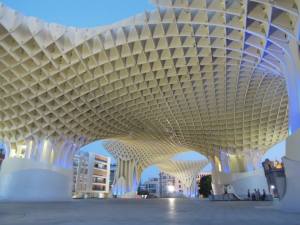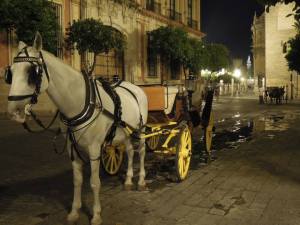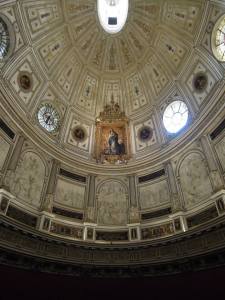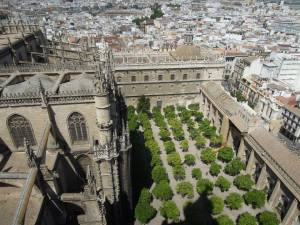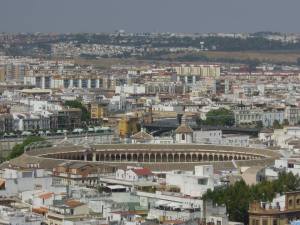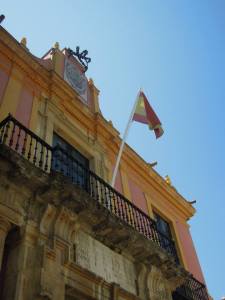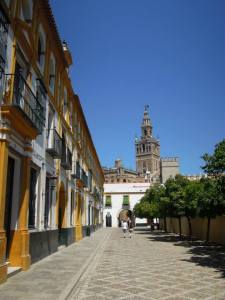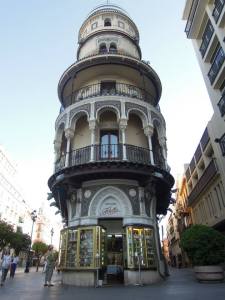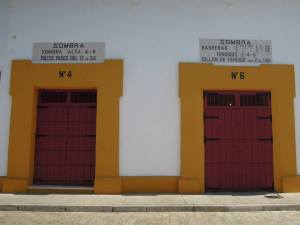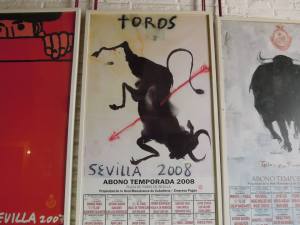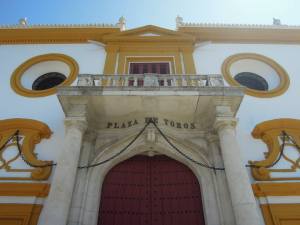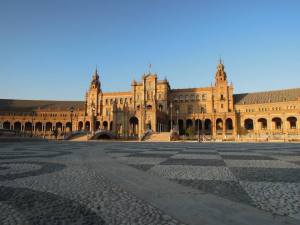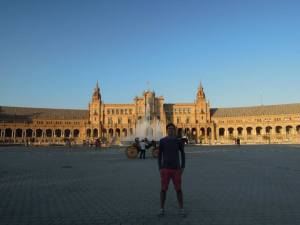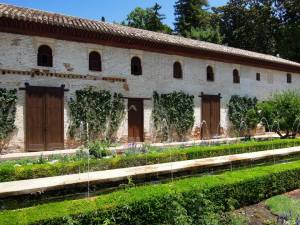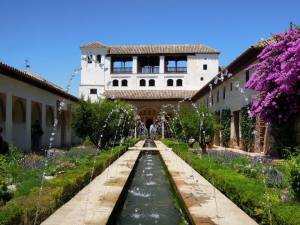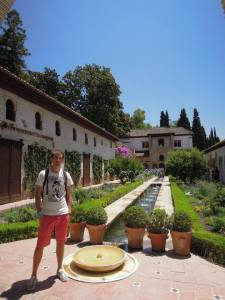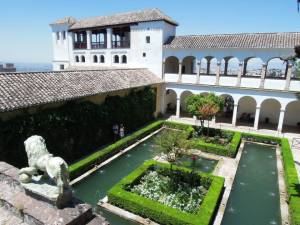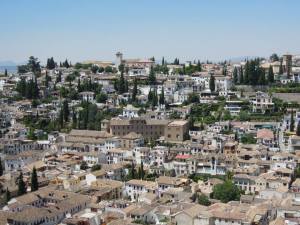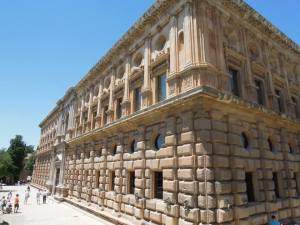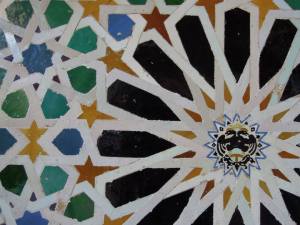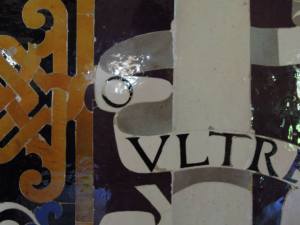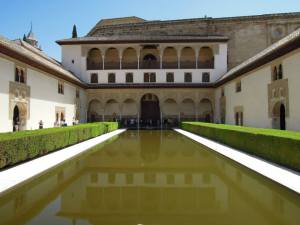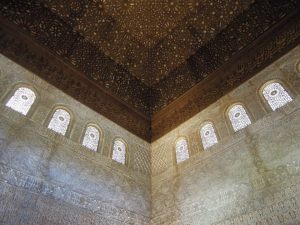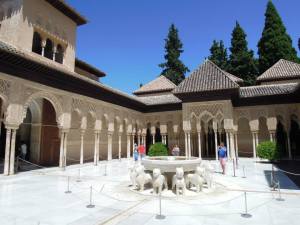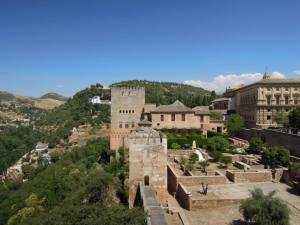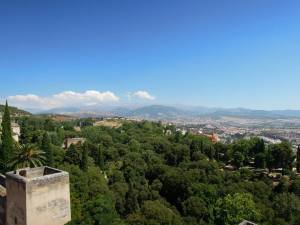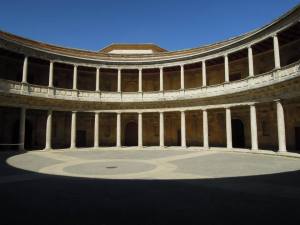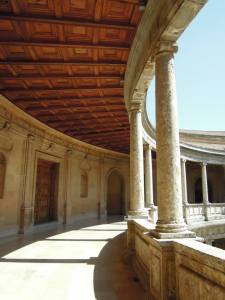Today is the first real day of winter in South Korea, the temperature plummeted to a frosty 2°C last night and I had to put a coat on for the first time this morning. The only recently browned and reddened autumn leaves have begun a rapid descent to the unevenly paved sidewalks and it’s making me very unhappy! A few Korean people have mentioned over the last few days that this has been forecast to be a long, deep and cold winter. To counter all these horrible unwanted wintery images that are being forced upon me I though I would take the time to finish my summer blog. It’s been a while and I have forgotten a little so I decided that this post, and the next, will be more of a photo blog, with a few sentences for each. Maybe an anecdote that sticks out, a bit of tiresome history or maybe nothing if the picture tells all already.
Sevilla:
After a six hour journey through the heart of Spain we dropped our stuff off at a fantastic hostel (Feeling Sevilla– It was that good it deserves a link). I grabbed a refreshing shower and we took a walk into Sevilla for the evening. We stumbled across this religious procession (it was an otherwise incredibly peaceful Sunday on the streets of Sevilla) going thought the streets surrounding the Alameda de Hercules.
The Alameda Hercules is the oldest public garden in Europe, although it is more of a square now lined with impressive rows of Poplar trees. It serves Sevilla now by being one of the hearts of its nightlife offerings. Cafes, restaurants, Tapas bars and Arab tearooms. These two huge Roman columns bear statues of Julius Caesar and Hercules.
After eating tapas we went across the city to the Metrosol Parasol, claimed to be the largest wooden structure in the world. We went too late to climb to the top but enjoyed walking around the terrace below the huge structure.
From the ultra-modern structure of the Metropol Parasol to La Giralda and The Cathedral of Seville. La Giralda was purpose built to be part of the chief mosque but historical events meant it was finally associated with the cities cathedral as its magnificent bell tower.
Around the streets of the old sector you can travel like you are still in the fifteenth century in a horse and cart…
After catching the cathedral at dark we returned the following day and paid the entrance fee to check out what was once the third largest cathedral in the world from the inside. Compared to the renaissance styled cathedrals of Italy, Seville’s Gothic cathedral was dark and imposing. The altar piece, although largely obscured by building works was intricately detailed and carved by one man over his entire life. The towering height of the nave is supported by soaring gargantuan columns, I felt like a muse staring up the legs of an elephant. Apparently this is the resting place of Christoper Columbus, although I didn’t know at the time. As well as the main body of the cathedral you can see an incredible baptistery in the photo above.
We paid to climb the sloping paths of the minaret and were rewarded of fantastic views of Sevilla and beyond. Here you can see down into the cathedral’s Court of Oranges.
The rotund stadium ceiling of the bull fighting arena.
Outside the Real Alcazar, a Moorish Palace where Columbus planned his trip to the Americas.
Looking back a cross to La Giralda.
An unusual building on the streets of Sevilla.
We didn’t pay to go into the bull fighting arena or museum but the outside was interesting enough. You can see the stalls that hold the bulls, a series of posters from the annual bullfighting festival (I picked my favourite) and one of the main entrances for patrons.
As dusk rolled in on the final, and only full day in Sevilla we went for a walk to the grounds of the Plaza de Espana before a final walk around the streets of Sevilla. We walked along the river and checked out a night market that was running along the shoreline.
When I think back to my time in Sevilla I remember it as being quite a relaxed affair, but in reality we squeezed quite a lot out of our short stay. We took our time and visited some of the standout historical and modern attractions that Sevilla has to offer. I would thoroughly recommend the climb up La Giralda and an evening around La Alemada Hercules. La Plaza Espana is a great setting in the evening and a walk along the far side of the river can be quite an adventure. I would not recommend a 10k run along the river in the full heat of a summer afternoon. That was not easy!
Granada:
Several hours east of Sevilla is Granada. Granada is a fairly dormant city in the shadow of the beginnings of the Sierra Nevada mountain range. At the end of July there was little chance of skiing so our short stay would be solely focused on visiting the Alhambra. The hostel was hidden in the backstreets of Granada and despite waiting for ages to check-in (we arrived behind a large group) we found it to be quite comfortable, good bunk beds and a great little kitchen. We went for Tapas in the late afternoon with two of our German room mates before I fell asleep rather than taking a quick nap. When I woke later I grabbed some ingredients from the local market and showed Elle how to cook some fresh pasta for the rest of her journey when I had headed back to England. In the evening we planned our trip to the Alhambra, it is essential to book tickets in advance, a day in advance is sufficient, and we did this online.
The following day we walked the reasonably short, if not steep, distance to the Alhambra. We arrived in line with the entrance time we had booked and collected our tickets. The grounds of the Alhambra are vast and diverse. An unplanned complex of palace and fortress that was constructed over a long time period giving it distinct and independent architectural styles. In the three photos, and the two below, you can see the the area known as the Generalife. A place where the kings of Granada would come to relax and forget about the pressures of the palace. The Generalife has complex, manicured, blossoming gardens and two patios. The Patio of the Cypress of the Sultana and the factually correct, but underwhelmingly titled, Patio of the Irrigation Ditch.
A view across Granada from the Patio of the Irrigation Ditch.
From the Generalife we walked through the largely ruined Upper Alhambra where you can see the foundations of many Arabic and Christian buildings. As we headed to the queue for the Nasrid Palaces we passed the rather bizarre Charles V Palace; a building that seemed so out of keeping with the older buildings of the palace. It seemed like someone had plunked a council house in the middle of Alderley Edge in Cheshire.
Some of the bold and colourful tiling that decorates large parts of the twelfth century Royal Complex. (Mexuar, Comares Tower and Court of the Myrtles).
Entrance to the Comares Palace.
Overlooking the eye-catching Court of the Myrtles.
Inside the cool and spacious palace buildings the walls are intricately decorated with plasterwork carvings.
The spectacularly architectural offerings of the Court of the Lions. (The lions being the ones that support the basin at the centre of the photo).
A close-up of the work that went into decorating the plasterwork of the palace buildings.
Away from the palace buildings we explored the defenses of the Alcazaba and the ruined Arms Square, a significantly contrasting image to that of the delicate gardens and intricate architecture of the palaces.
A stunning view across to the Sierra Nevada.
Having skirted the outside of the monstrosity of the Charles V Palace I wasn’t quite prepared for the dramatic pillared circular courtyard at the heart of the Catholic palace.
After a full afternoon at the Alhambra, Elle and I took a walk along the lower banks of the Alhambra in the evening. A drying river meandered between the Alhambra’s steep cliff sides and the terraced walls of the shore. We enjoyed some ice-cream and watched a gang of cats stalk a river guided tour group that were traversing the river basin below. Granada is an airy and peaceful town that is crowned by the imposing beauty and history of the Alhambra that over looks it. Not only is it a must see for visitors in Spain but one for travelers in general.

